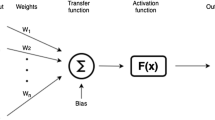Abstract
The efficient accomplishment of missions can often be enhanced by the simultaneous operation of multiple unmanned aerial vehicles (UAVs). Easily scalable control algorithms are crucial for the implementation of such operational concept. One promising practical option is swarm intelligence, which is based on a behavioral model and boasts of characteristics such as flexibility, robustness, decentralized control, and self-organization. In this paper, a neural net controller that evolved via evolutionary robotics is applied to the control of multiple UAVs with the mission to search a bound area as thoroughly as possible. By applying incremental evolution techniques, a neural net controller that minimizes energy consumption without sacrificing performance in area coverage and collision avoidance can be developed. A much higher survival rate of UAVs can be achieved by applying a three-dimensional (3-D) maneuver for collision avoidance with an efficient algorithm for minimizing fuel consumption by suppressing excessive altitude maneuver. Numerical demonstrations are shown to validate the effectiveness of the proposed 3-D area search algorithm with minimum altitude maneuver.
Similar content being viewed by others
References
B. Crowther and X. Riviere, Flocking of autonomous unmanned air vehicles, 17th Bristol UAV Conference, (2002).
E. Kuiper and S. N. Tehrani, Mobility models for uav group reconnaissance applications, Wireless and Mobile Communications, (2006).
C. A. Erignac, An exhaustive swarming search strategy based on distributed pheromone maps, AIAA Infotech@Aerospace 2007 Conference and Exhibit, (2007).
V. D. Parunak, M. Purcell and R. O’connell, Digital pheromones for autonomous coordination of swarming UAV’s, 1st AIAA Unmanned Aerospace Vehicles, Systems, Technologies, and Operations Conference, (2002).
R. J. Bamberger, D. P. Watson, D. H. Sheidt and K. L. Moore, Flight Demonstrations of unmanned aerial vehicle swarming concepts, Johns Hopkins APL Technical Digest, 27(1), (2006).
J. A. Sauter, R. M. Matthews, V. D. Parunak and S. A. Brueckner, Performance of digital pheromones for swarming vehicle control, 4th International Joint Conference on Autonomous Agents and Multi-Agent Systems, (2005).
P. Gaudiano, B. Shargel, E. Bonabeau and B. T. Clough, Swarm intelligence: a New C2 paradigm with an application to control of swarms of UAVs, 8th ICCRTS Command and Control Research and Technology Symposium, (2003).
P. Vincent and I. Rubin, A framework and analysis for cooperative search using uav swarms, Association for Computing Machinery Symposium on Applied Computing, (2004).
S. Hauert, S. Leven, M. Varga., F. Ruini, A. Cangelosi, J. C. Zufferey and D. Floreano, Reynolds flocking in reality with fixed-wing robots: communication range vs. maximum turning rate, International Conference on Intelligent Robots and Systems (IROS), (2011) 5015–5020.
T. Stirling, J. Roberts, J. C. Zufferey and D. Floreano, Indoor navigation with a swarm of flying robots, International Conference on Robotics and Automation (ICRA), (2012) 4641–4647.
E. Bonabeau, M. Dorigo and G. Theraulaz, Swarm Intelligence: from Natural to Artificial Systems, Oxford University Press, (1999).
C. W. Reynolds, Flocks, Herds and Schools: A distributed behavioral model, Computer Graphics, 21(4) (1987) 25–34.
S. Nolfi and D. Floreano, Evolutionary Robotics; The Biology, Intelligence, and Technology of Self-Organizing Machines, MIT Press, (2000).
M. D. Richards, D. Whitley and J. R. Beveridge, Evolving cooperative strategies for UAV teams, Genetic and Evolutionary Computation Conference, (2005).
F. Ruini and A. Cangelosi, Distributed control in multi-agent systems: a preliminary model of autonomous mav swarms, 11th International Conference on Information Fusion, (2008).
R. D. Nardi, O. Holland, J. Woods and A. Clark, Swar-MAV: A Swarm of Miniature Aerial Vehicles, 21st Bristol UAV Systems Conference, (2006).
D. Floreano, S. Hauert, S. Leven and J. C. Zufferey, Evolutionary swarms of flying robots, International Symposium on Flying Insects and Robots, (2007).
G. J. Barlow, C. K. Oh and E. Grant, Incremental evolution of autonomous controllers for unmanned aerial vehicles using multi-objective genetic programming, IEEE Conference on Cybernetics and Intelligent Systems, (2004).
A. Cangelosi and F. Ruini, Communication and Distributed Control in Multi-Agent Systems, AFRL-AFOSR-UK-TR-2011-0027, Air Force Research Laboratory, (2011).
S. Hauert, J. C. Zufferey and D. Floreano, Reverse-engineering of artificially evolved controllers for swarms of robots, IEEE Congress on Evolutionary Computation (CEC), (2009) 55–61.
F. Ruini and A. Cangelosi, An evolutionary robotics 3D model for autonomous MAVs navigation, target tracking and group coordination, International Joint Conference on Neural Networks (IJCNN), (2010) 760–767.
F. Ruini and A. Cangelosi, An incremental approach to the evolutionary design of autonomous controllers for micro-unmanned aerial vehicles, 11th Conference Towards Autonomous Robotic Systems (TAROS), (2010) 239–246.
F. Ruini and A. Cangelosi, Extending the evolutionary robotics approach to flying machines: An application to MAV teams, Neural Networks, 22(5–6) (2009) 812–821.
F. Ruini, A. Cangelosi and F. Zetule, Individual and cooperative tasks performed by autonomous mav teams driven by embodied neural network controllers, International Joint Conference on Neural Networks (IJCNN), (2009) 2717–2724.
S. Oh and J. Suk, Area Search of Multiple UAV’s based on Evolutionary Robotics, Journal of the Korean Society for Aeronautical & Space Sciences, 38(4) (2010) 352–362.
M. R. Anderson and A. C. Robbins, Formation Flight as a Cooperative Game, Proceedings of the AIAA GNC Conference and Exhibit, (1998) 244–251.
M. Mitchell, An Introduction to Genetic Algorithms, MIT Press, (1998).
I. Harvey, P. Husbands and D. Cliff, Seeing the light: Artificial evolution, real vision, Proceedings of the Third International Conference on Simulation of Adaptive Behavior, (1994) 704–720.
Author information
Authors and Affiliations
Corresponding author
Additional information
Recommended by Associate Editor Sangyoon Lee
Soo-Hun Oh received his B.S. and M.S. degrees in Aerospace Engineering from Seoul National University in 1988 and 1990, respectively. He received his Ph.D degree in Aerospace Engineering from Chungnam National University in 2010. His research interests include control of multiple UAVs, evolutionary robotics, and swarm robotics.
Jinyoung Suk received his Ph.D degree from Seoul National University. He joined the Department of Aerospace Engineering of the Chungnam National University in 2001. His research interests include UAVs, flight dynamics, and flight control.
Rights and permissions
About this article
Cite this article
Oh, SH., Suk, J. Evolutionary controller design for area search using multiple UAVs with minimum altitude maneuver. J Mech Sci Technol 27, 541–548 (2013). https://doi.org/10.1007/s12206-012-1238-1
Received:
Revised:
Accepted:
Published:
Issue Date:
DOI: https://doi.org/10.1007/s12206-012-1238-1




